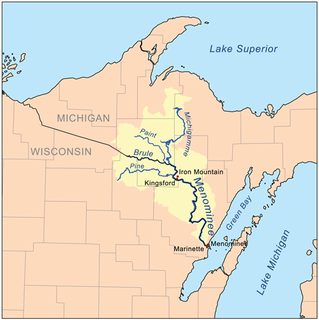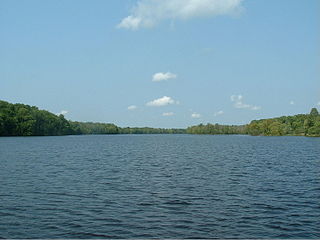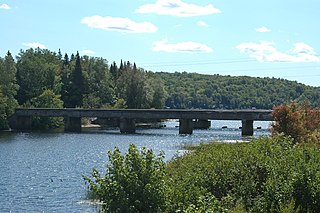| Paint River | |
| Country | United States |
|---|---|
| State | Michigan |
| Type | Recreational |
| Designated | March 3, 1992 |
Paint River is a 45.5-mile-long (73.2 km) [1] river in the U.S. state of Michigan.

In the United States, a state is a constituent political entity, of which there are currently 50. Bound together in a political union, each state holds governmental jurisdiction over a separate and defined geographic territory and shares its sovereignty with the federal government. Due to this shared sovereignty, Americans are citizens both of the federal republic and of the state in which they reside. State citizenship and residency are flexible, and no government approval is required to move between states, except for persons restricted by certain types of court orders. Four states use the term commonwealth rather than state in their full official names.

Michigan is a state in the Great Lakes and Midwestern regions of the United States. The state's name, Michigan, originates from the Ojibwe word mishigamaa, meaning "large water" or "large lake". With a population of about 10 million, Michigan is the tenth most populous of the 50 United States, with the 11th most extensive total area, and is the largest state by total area east of the Mississippi River. Its capital is Lansing, and its largest city is Detroit. Metro Detroit is among the nation's most populous and largest metropolitan economies.
It is a tributary of the Brule River and flows through Gogebic and Iron counties. Via the Brule River, it is part of the Menominee River watershed, flowing to Lake Michigan.

The Brule River is a 52.3-mile-long (84.2 km) river in the U.S. states of Michigan and Wisconsin. Nearly the entire course forms a portion of the boundary between the two states.

Gogebic County is the westernmost county in the Upper Peninsula in the U.S. state of Michigan. As of the 2010 census, the population was 16,427. The county seat is Bessemer. This was historically part of the territory of the Lake Superior Band of Chippewa, which had twelve bands in Michigan, Wisconsin and Minnesota. The Lac Vieux Desert Indian Reservation is in this county, in Watersmeet Township, as the land base of one of the federally recognized tribes.

Iron County is a county in the Upper Peninsula of the U.S. state of Michigan. As of the 2010 United States Census, the population was 11,817. The county seat is Crystal Falls.
The Paint River flows through Crystal Falls, Michigan, and empties into the Brule River before its confluence with the Michigamme River to form the Menominee.

Crystal Falls is a city in the U.S. state of Michigan. As of the 2010 census, the city population was 1,469. It is the county seat of Iron County. The city is located within Crystal Falls Township, but is a separate municipal entity. The area first developed as a major center for iron mining and the timber industry; it has become increasingly popular for tourism in recent years.

The Michigamme River is a 67.0-mile-long (107.8 km) tributary of the Menominee River on the Upper Peninsula of Michigan in the United States. Via the Menominee River, its water flows to Lake Michigan.





